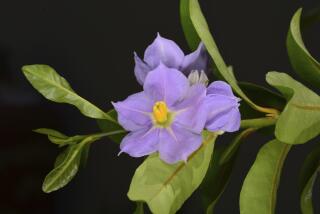$1.5-Billion Fund Urged to Save Food Sources : Agriculture: Experts propose a global effort to keep plant species from vanishing. Many expect the U.S. to balk.
- Share via
After three years of often acrimonious negotiations, the world’s leading experts on plant genetic resources have hammered out a proposal to conserve biological diversity in plants--the backbone of the world’s agricultural system.
The proposal, released in draft form this week, calls for an internationally funded, $1.5-billion program to shore up existing plant conservation efforts. The call for a global initiative takes long strides toward resolving issues that have been the source of quibbling between industrialized nations and the Third World.
The proposal comes at the end of a series of international meetings, sponsored by Colorado’s Keystone Center, among key figures in the debate. The final report, developed at the last Keystone session in Oslo in May and June, is expected to be considered at the next major U.N. Conference on Environment and Development, slated for Brazil in 1992.
While world food demand is expected to double in the next 25 years, environmental pressures are increasingly jeopardizing varieties of important food crops. A quarter of the world’s 250,000 plant species could vanish in the next 50 years, the Keystone report contends.
Other issues, such as preservation of rain forests and global warming, often take the conservation spotlight and may dominate the conference agenda. But participants in the Keystone symposium say there is no more critical need than to protect the world’s ability to feed itself, and they express confidence that the proposal will win at least partial approval in Brazil.
Donald Plucknett, science adviser at the World Bank and a participant in the Keystone symposium, said he feels certain that the proposal will win funding, “but whether it will be funded anywhere near the levels we have requested, I don’t know.”
The U.S. government, which under the proposal would bear 25% of the program’s funding burden, could be a major stumbling block. The official American attitude toward previous international efforts on plant conservation has often been lukewarm; for many years, Washington refused to participate in such attempts by the U.N. Food and Agriculture Organization.
When the organizers of the U.N. conference meet next month in Geneva to set the agenda for the Brazil conference, the Keystone proposal will most likely be championed by a number of nations, including several European and Third World delegates--but not the United States.
Pat Mooney, a Canadian advocate of crop conservation and a participant in the Keystone forum, said the rest of the international community expects the United States to balk at the funding plan.
“I think the U.S. government officials who deal with plant genetic resources have exactly the same sense of alarm that I have. . . . But the White House, or the Congress, has a snooze button” on this issue, Mooney said. “The rest of the world, the Europeans and the Third World, assumes the U.S. will come along five to 10 years later.”
Thorny issues such as farmers’ rights and patent laws have kept the industrialized nations of the Northern Hemisphere and the underdeveloped nations of the Southern Hemisphere from reaching agreement on how best to save and use nature’s storehouse of genetic materials. The rich plant diversity of the South has long contributed to the advanced agricultural systems of the North, most often without compensation for genetic materials.
Perhaps the most significant aspect of the Keystone symposium is that it marked the first time opposing sides were able to reach a truce in the so-called seed wars.
The Keystone Center, an environmental mediation group, sponsored the meetings of 41 individuals from 22 countries. It included government agriculture ministers, representatives of some of the largest seed companies in the world and advocates for the rights of Third World farmers.
The proposed fund would support existing conservation efforts, including an international network of “banks” for seeds and genetic materials, and target areas for on-site conservation.
More to Read
Sign up for Essential California
The most important California stories and recommendations in your inbox every morning.
You may occasionally receive promotional content from the Los Angeles Times.













